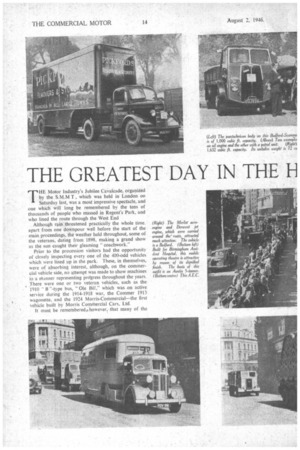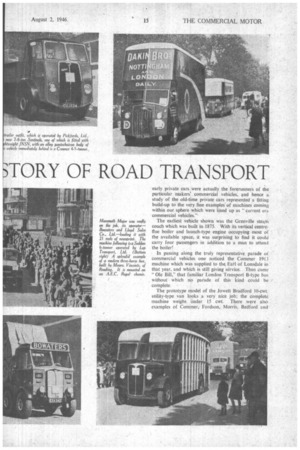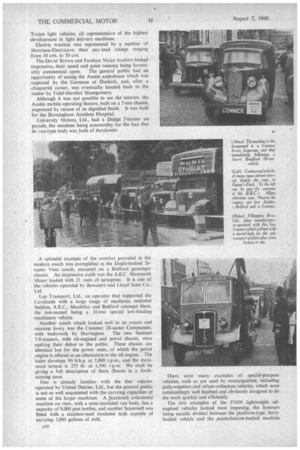THE GREATEST DAY IN THE H TORY OF ROAD TRANSPORT
Page 34

Page 35

Page 36

If you've noticed an error in this article please click here to report it so we can fix it.
THE Motor Industry's Jubilee Cavalcade, organized by the S.M.M T, which was held in London on Saturday last, was a most impressive spectacle, and one which will long be remembered by the tens of thousands of people who massed in Regent's Park, and v.ho lined the route through the West End
Although rain threatened practically the whole time. apart from one downpour well before the start of the main proceedings, the weather held throughout, some of the veterans, dating from 1898, making a grand show as the sun caught their gleaming "coachwork."
Prior to the procession visitors had the opportunity of closely inspecting every one of the 400-odd vehicles which were lined up in the park. These, in themselves, were of absorbing interest, although, on the commercial vehicle side, no attempt was made to show machines in a Minnet representing prilgress throughout the years. There were one or two veteran vehicles, such as the 1910 " B --type bus, "Ole Bifl," which was on active service during the 1914-1918 war, the Commer 1913 wagonette. and the 1924 Morris-Commercial—the first vehicle built by Morris Commercial Cars, Ltd.
It must be remernbered.however, that many of the early private cars were actually the forerunners of the particular "makers' commercial vehicles, and hence a study of the old-time private cars represented a fitting build-up to the very fine examples of machines coming within our sphere which were lined up as "current era commercial vehicles."
The earliest vehicle shown was the Grenville steam coach which was built in 1875. With its vertical centreflue boiler and launch-type engine occupying most of the available space, it was surprising to find it could carry four passengers in addition to a man to attend the boiler!
• In passing along the truly representative parade of commercial vehicles one noticed the Commer 1913 machine which was supplied to the EMI of Lonsdale in that year, and which is still giving service. Then came "Ole Bill," that familiar London Transport B-type bus without which no parade of this kind could be complete.
The prototype model of the Jowett 'Bradford 10-cwt. utility-type van looks a very nice job; the complete machine weighs Under 15 cwt. There were also examples of Commer, Fordson, Morris, Bedford and
Trojan light vehicles, all representative of the highest development in light delivery machines.
Electric traction was represented by a number of Morrison-Electricars, their pay-load ratings ranging from 10 cwt. to 50 cwt.
The David Brown and Fordson Major tractors looked impressive, their speed and quiet running being favourably commented upon. The general public had an opportunity of seeing the Austin ambulance which was captured by the Germans at Dunkirk, and, after a chequered career, was eventually handed back to the maker by Field-Marshal Montgomery.
Although it was not possible to see the interior, the Austin mobile operating theatre, built on a 5-ton chassis, impressed by reason of its dignified finish. It was built for the Birmingham Accident Hospital.
University Motors, Ltd., had a Dodge 5-tonner on parade, the machine being noteworthy for the fact that its van-type body was built of duralumin.
A splendid example of the comfort provided in the modern coach was exemplified in the Duple-bodied 26seater Vista coach, mounted on a Bedford passenger chassis. ,An impressive outfit was the A.E.0 Mammoth Major loaded with 21 reels of newsprint. It is one of the vehicles operated by Bowaters and Lloyd Sales Co., Ltd.
Lep Transport, Ltd., an operator that supported the Cavalcade with a large range of machines, included Seddon, A.E.C., Maudslay and Bedford amongst them, the last-named being a 10-ton special low-loading machinery vehicle.
Another coach which looked well in its cream and maroon livery was the Commer 28-seater Commando, with bodywork by Harrington. The two Sentinel 7-8-tonners, with oil-engined and petrol chassis, were making their debut to the public. These chassis are identical but for the power units, of which the petrol engine is offered as an alternative to the oil engine. The latter develops 90 b.h.p. at 2,000 r.p.m., and the maximum torque is 255 lb. at 1,500 r.p.m. We shall be giving a full description of these eliassis in a forthcoming issue.
One. is already familiar with the fine vehicles operated by United Dairies, Ltd., but the general public is not so well acquainted with the carrying capacities of some of the larger machines. A Scammell articulated machine on view, with a semi-insulated van body, has a capacity of 9,000 pint bottles, and another Scammell was fitted with a stainless-steel insulated tank capable of carrying 3,000 gallons of milk. There were many examples of special-purpose vehicles, such as are used by municipalities, including gully-emptiers and refuse-collection vehicles, which were outstandingly well finished and obviously designed to do the work quickly and efficiently.
The two examples of the JNSN lightweight oilengined vehicles looked most imposing, the honours being equally divided between the platform-type, lorrybodied vehicle and the pantechnicon-bodied machine




































































